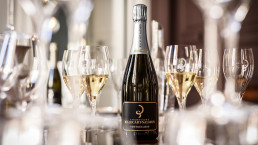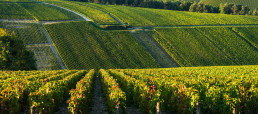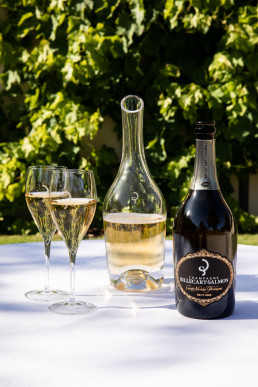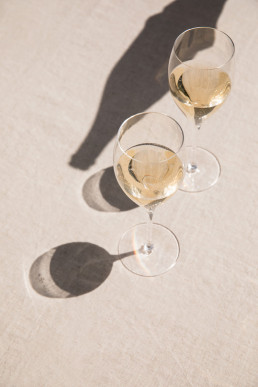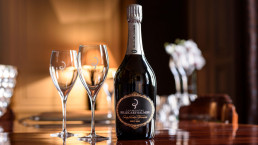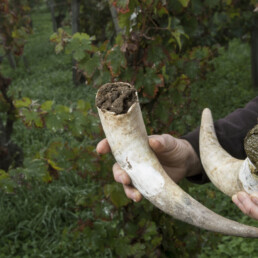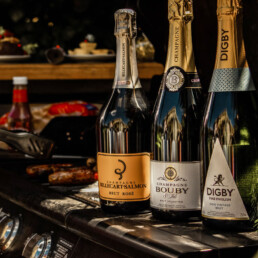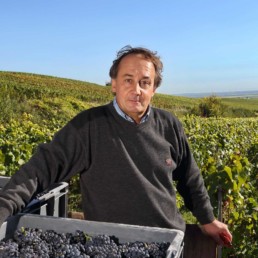Champagne: A Vintage Affair
"Heavens, we need cheer and conviviality at the moment – and what more cheering and convivial than a glassful of bubbles?" - Jancis Robinson MW
The sight and sound of that POP! of a bottle of champagne is enough to turn the head of any wine fan at this time of the year especially after the roller coaster ride of 2021! Of course, valued fellow imbibers, you trust us enough when we tell you there’s something next level to taste in a chilled glass of liquid luxury, that is – VINTAGE CHAMPAGNE.
Of course, vintage anything is having a cool-kid moment, and vintage champagne is no exception, albeit in a major wine geek kind of way. With the fizz-laden festivities of Christmas and the New Year fast approaching, it’s only fitting that here at Dhall & Nash we’ve turned our attention to the joyful extravagance of vivacious vintage champagne!
Christmas’ feel-good vibe inspires us to open more bottles of champagne than at any other time of the year. But as we float from party-to-party and gift-to-gift, champagne becomes little more than a celebratory tipple or a means to ease into our dreamy slothful southern hemisphere summer. Most of you could happily opt for a familiar offering that is more than likely a non-vintage cuvée. But for the true aficionado, vintage means everything when it comes to champagne.
OK. It’s time for us to take it up a notch! Let’s ‘do’ vintage. Vintage champagne remains the ultimate luxury libation: favoured by wine collectors, investors, wine geeks and of course, the rich and famous. Always considered an essential toast at important occasions. At Dhall & Nash we are definitely fizz enthusiasts, but we can also understand why some tipplers may feel overwhelmed at the plethora of options available when you want to pop a cork. Let’s look at what makes vintage champagne so special and what’s behind the big bucks that people are prepared to pay for the real deal!
“Great Champagne is a gift you never forget.”
Erin Brooks, Wine writer for RobertParker.com
What's the Difference Between Vintage & Non-Vintage Champagne?
When it comes to bubbles, not all champagne is created equal. Some of the most famous champagne brands in the world, such as Dom Pérignon, Salon and Cristal, only exist as vintages. With many differences in style, production and taste, vintage champagne is much more than an expensive version of regular fizz.
Looking at the labels on bottles of bubbles on shop shelves you’ll not likely see a year written. That’s because most champagne is non-vintage (NV), or ‘Champagne sans année’ as the French more attractively describe it. Non-vintage champagne is made from a blend of two or usually more harvests and accounts for the vast majority of champagne production.
For the grandes marques champagne houses, the aim here is to produce a consistent signature style and to avoid the effects of inclement weather events that the region is prone to. Let’s say it’s their polished calling card, their brand identity.
In contrast, vintage Champagne – or more correctly, ‘millésimé’ – has to be 100% from the year indicated on the label and, as a result, is more variable in style. It is, in effect, a true expression of one single harvest. The character of the year gives the characteristics of the vintage, but the step up in quality and intensity of flavour comes from the selection of the best grapes from Champagne’s top terroir.
Think of vintage champagne like single-origin coffee or chocolate. Basically, what you’re getting from any of these things is an expression of a particular place and time. And that makes it extremely exciting and rather grand when it comes to vintage champagne.
The true beauty of vintage cuvées is that it best demonstrates that champagne is a fine wine that can be kept for many years without losing all its zip and freshness, at the same time developing aromas, flavours and complexity that set it apart from other top sparkling wines.
Which are the Great Vintages for Champagne?
“A vintage champagne is a joint venture between the winemaker and the climate.”
Olivier Krug, legendary Champagne House owner
It used to be said that vintage champagne is typically released by the majority of producers three or four times a decade – only when the weather in this, the most northerly of France’s wine regions, is judged to be exceptional. However, since the turn of the millennium, Champagne has experienced generally warmer summers and looks likely to muster five high-quality vintages in a decade.
However, there is no template for the perfect year – considering the fickleness of Mother Nature. Potentially any year can be a ‘vintage’ year in Champagne, and clearly certain vintages are more highly regarded than others.
The style of the vintage depends on a series of complicated factors where temperature, sunshine hours and rainfall are of great importance. The decisive factor is mainly how these components are distributed during the year.
The personality of the different vintages is one of the champagne taster’s greatest joys. Some are most fond of the powerful alcoholic vintages with excess heat such as 1947, 1959, 1976, 1989, 1990, 2003 and 2015, while others prefer vintages that gave cooler, tart, elegant and fine-tuned champagnes, such as: 1919, 1952, 1966, 1969, 1971, 1979, 1981, 1985, 1988, 1996 and 2008.
Regardless of which years are preferred, the different vintages have a rich variety that makes wine tasting even more scintillating.
Then there are the vast differences between Champagne houses – each has its own individual slant on its winemaking process. Take the revered Salon, for example. They announced in 2014 that they would not be making a 2012 vintage, claiming that there has not been a genuinely great vintage in Champagne since 2008. Other houses were quick to disagree, however, with many billing 2012 as a legendary year, and critic Robert Parker giving the overall vintage an impressive 96 points.
The best Champagne vintages of the 21st century have been: 2000, 2002, 2008, 2012, 2013, and 2014.
Because of the long ageing that vintage Champagne typically undergoes, it’s still too early to properly assess the vintages of more recent times, but as far as Robert Parker’s conclusions go, the 2014, 2013 and, notably, the 2012 have all proved excellent. The 2008 is arguably the standout so far since the turn of the century however, with Parker awarding it 99 points. Its success was something of a surprise to all, since the year opened with widespread mildew meaning expectations were low. The 2000 and 2002 have also been very well received.
But guess what? If the Champagne house declares its grapes are worthy of being a vintage year – there’s going to be some seriously great juice in that bottle!
So, What is a Prestige Cuvée?
The producers’ very best champagnes are considered Prestige Cuvées. Prestige Cuvées are made from the finest grapes from the best locations of the vineyards. They are typically aged from 5 to 8 years with more complex, elegant, and intense aromas, and flavours. These wines are typically very limited and very expensive. The famous Prestige Cuvées Champagnes are Dom Pérignon and Cristal from Louis Roederer. Although Prestige Cuvées are mainly vintage champagnes, they can be non-vintage.
“Good Champagnes conform to the rules. Really great Champagnes often break them!”
Pierre Larmandier of Champagne Larmandier-Bernier
What's With that Price Tag?
Basically, three factors dictate costs. Scarcity, time spent ageing, and terroir quality. Vintage champagne is a very small category, representing only 1.5 percent of shipments from the region, as opposed to 78.5 percent for non-vintage cuvées. Given this limited production, as well as stricter regulations on its ageing, vintage champagnes have a special aura to them, kind of like being a member at an exclusive private club.
The other defining characteristic of vintage champagne is that, by law, it must be aged a minimum of three years. By comparison, non-vintage Champagne has a 15-month minimum. In fact, the top vintage champagnes tend to be aged for much longer before being released to the market. Then leading Champagne houses, like Billecart-Salmon, will generally release the wine to market when they believe the champagne is ready for consumption and not necessarily in chronological order.
This ageing process results in the Champagnes having much longer contact with the lees, where they derive their biscuit, brioche and nutty flavours that gives the champagne more complexity, while protecting it so that it can age for longer in bottle and develop incredible depth and precision.
Once a vintage is made it can never be remade and once released to market each vintage is steadily consumed, meaning that as the quality improves, the supply decreases, creating an inverse supply curve. Production of these prestigious cuvees tends to be very small and cannot meet global demand.
So, you ask, but are they worth the money? Hell yes! They’re profoundly complex and totally unique. They’re rare! What are you waiting for – place that order! ☺
Vintage Champagne is Investible:
The best vintage champagne bottles are prized for their complex notes but also for some people, for their investment potential – stemming mainly from scarcity and meticulous winemaking practices. When compared to similarly rated and evaluated Bordeaux and Burgundies, vintage champagne is relatively affordable. Therefore, it offers investors a lower entry point and value for money when diversifying their portfolios or when starting out.
With production and therefore supply being very restricted, vintage champagne maintains an incredibly strong consumption market too, readymade in top end nightclubs, hotels, restaurants, and private members clubs around the world. The remainder goes to private collectors’ portfolios or cellars, who buy within a few years of release and as a result pay a lot less in the future when they choose to drink it, or alternatively resell it for a profit.
What to Expect From Vintage Champagne:
Flavour-wise, we know that vintage champagne is a very different beast to non-vintage champagne. NV champagne is generally revered for being fresh, acidic, and very fizzy. Vintage champagne is often less fizzy, much richer, and more like a great white Burgundy.
Vintage champagne gains wonderful secondary aromas and flavours with age, including those of dried fruit, honey, hazelnut, and biscuit, and also acquires a toastiness and creaminess with maturity. Over the years, the carbonation will mellow, leading to soft tingling fizz along with bright levels of acidity on the palate. Simultaneously capturing freshness, refined elegance, and mesmerising complexity – they become truly magical vinous masterpieces.
How to Serve Vintage Champagne:
“My dear girl, there are some things that just aren’t done, such as drinking Dom Perignon ’53 above the temperature of 38 degrees Fahrenheit. That’s just as bad as listening to the Beatles without earmuffs!”
James Bond in Goldfinger (1964)
Interesting how the coolest Secret Agent 007 could screw up back in the day! James Bond got 1 out of 3 on the money. Namely, he was drinking classy vintage champagne but at the wrong temperature. And he definitely missed his target on the legendary Beatles. ☺
Moving into the twenty-first century, we now know to treat vintage champagne differently to enjoy fully the complex flavours. Always allow the vintage to breathe for up to 30 minutes first to release maximum aromas.
Renown champagne boss Antoine Rolland-Billecart of Billecart-Salmon says wine is like a human being in the cold. “Put yourself out in the snow and you won’t show anything either, you’ll be covered up!” he says. Three degrees breaks everything in champagne. It should be served at cellar temperature, (10-12 degrees Celsius) and never below eight degrees for NV and rosé.
As for the glasses, well, using decent glassware is essential for fully appreciating aged champagne. Those in the know and the Champenois themselves, prefer slightly wider glasses than typical champagne flutes, to allow their finest cuvees space to open out. Think somewhere between a flute and a fine white wine glass with a slight curve-in at the top. The traditional elongated flute holds its bubbles longest. But vintage champagne is a fine wine and it’s not just about the “scenery” – it’s about the aromatics, the many nuances on the palate. Finally, the flat champagne ‘coupe’ is a total no-no. The large open surface area evaporates both bead and aroma rapidly. Whilst the wide rim means that the wine is spilled to the sides of the tongue, where sensitivity to acidity is heightened. Non! Quel horreur!
As you’ve read here, vintage cuvées demonstrate best that champagne is a wine that can be kept for many years without losing any of its zip and freshness, at the same time developing aromas, exotic flavours and spellbinding complexity that set it apart from other top sparkling wines.
And if you ask us at Dhall & Nash, any time is a good time to sip some bodacious bubbly. Perhaps we can take a little life lesson after the past 2 years of loony lockdowns and tough times – why wait? – go pop a cork of something exceptional and vintage for someone special right now! Or ‘sleigh’ your gift list and really impress with a few vintage champagne charmers.
Delve into our Dhall & Nash vintage champagne selection and discover champagne’s astounding ability to age oh-so gracefully and to please every refined palate:
Our Vintage Champagne From Billecart-Salmon:
“The mark of Billecart is made not by the heavy footfall of concentration, power and presence, but rather the fairy touch of delicacy and crystal-clear fidelity.”
Tyson Stelzer, Acclaimed Champagne Specialist & Wine Critic
Billecart-Salmon makes one of the greatest rosés in the world – so treat yourself, you deserve it! This is vintage rosé at its finest and from one of the greatest Champagne vintages in modern memory!
Meet our Dhall & Nash poster-girl of vintage champagne – she’s all class. The 2008 Billecart-Salmon Cuvée Elisabeth Salmon Brut Rosé Champagne has been endlessly and deservedly featured in wine reviews and on magazine covers. Cleverly, the raciness of the outstanding 2008 vintage has been married perfectly to the richness and power of the old vine Pinot that gives this wine its colour. It is a knockout!
The 2008 Cuvée Elisabeth Salmon Rosé is made mostly from Grand Cru vineyards, but it is the Premier Cru that goes into it that makes it so special. The red wine that gives this rosé its colour comes from a small plot of 80-year-old Pinot Noir in Mareuil-sur-Aÿ called the Valofroy. This parcel, adjacent to the Clos des Goisses, faces due south and directly down at the Marne. The production from this ancient site is the limiting factor for the production of this rare tête de cuvée. The wine is composed of 55% Pinot Noir and 45% Chardonnay, and the red wine makes up just about 10% of the total.
2008 Champagne Billecart-Salmon Cuvée Elisabeth Salmon Brut Rosé
2007 Champagne Billecart-Salmon Cuvée Nicolas François Brut
2006 Champagne Billecart-Salmon Cuvée Nicolas François Brut 1.5L Magnum
2009 Champagne Billecart-Salmon Vintage
Our Vintage Champagne From Egly-Ouriet:
Egly-Ouriet is… “A breath of fresh air in a region saturated with marketing froth.”
Tyson Stelzer, Acclaimed Champagne Specialist & Wine Critic
Domaine Egly-Ouriet Vintage Champagne is unforgettable. What you’ll find at this “grower” house is truly champagnes striking in their concentration and complexity. Egly-Ouriet Champagne is age-worthy, sumptuous and at times surreal; these wines are unquestionably the pinnacle of Pinot Noir-based Champagne.
2011 Champagne Egly-Ouriet Brut Millésime Grand Cru
Our Vintage Champagne From Larmandier-Bernier:
Larmandier-Bernier is a renowned Maison de Champagne located in the Côte de Blancs that biodynamically cultivates its 18 hectares of vineyards, prioritising the preservation of old vines that are cultivated with minimal intervention.
Ever the purists, Larmandier-Bernier utilize only indigenous yeasts, separate vinification for each cru, and little to no dosage for an unadulterated expression of terroir in their wines. The wines are vinified in a variety of stainless-steel tanks; large, old, wood foudres; enamel-lined tanks; or smaller Burgundian barrels, depending on each cru and each vintage.
2014 Champagne Larmandier-Bernier Premier Cru Terre de Vertus Non-Dosé Blanc de Blancs
From all of us at Dhall & Nash to all of you, our truly valued fellow imbibers ☺
Happy Holidays full of fun and fabulicious vintage fizz!
For orders please email us at orders@dnfinewine.com.
